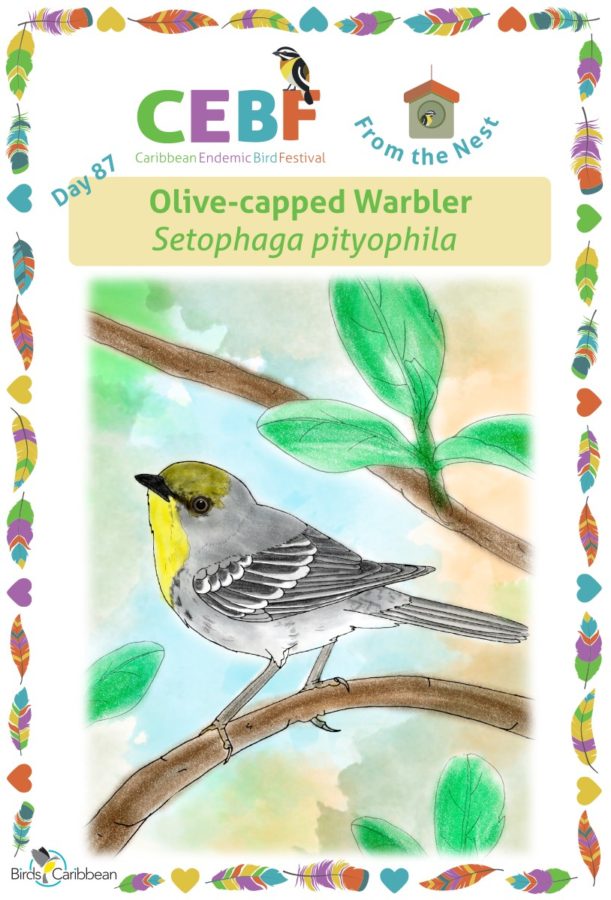Celebrate the Caribbean Endemic Bird Festival (CEBF) with us! Our theme in 2022 is “Loving Birds is Human Nature” Have fun learning about a new endemic bird every day. We have colouring pages, puzzles, activities, and more. Download for free and enjoy nature with your family at home.
Endemic Bird of the Day: Olive-capped Warbler
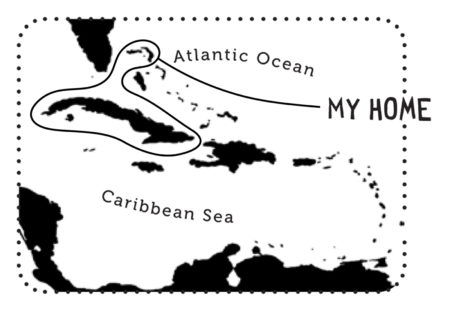 Hopping from pine tree to pine tree and crowned with…well, an olive-yellow colored cap, the Olive-capped Warbler is a lively little Caribbean endemic bird.This warbler is found only in pine woodlands where it feeds on insects and other tasty morsels of arthropods. It is restricted to two countries in the Caribbean: Cuba and The Bahamas. In the Bahamas it can be found on the islands of Abaco and Grand Bahama while in Cuba it is restricted to the western and eastern parts of the island.
Hopping from pine tree to pine tree and crowned with…well, an olive-yellow colored cap, the Olive-capped Warbler is a lively little Caribbean endemic bird.This warbler is found only in pine woodlands where it feeds on insects and other tasty morsels of arthropods. It is restricted to two countries in the Caribbean: Cuba and The Bahamas. In the Bahamas it can be found on the islands of Abaco and Grand Bahama while in Cuba it is restricted to the western and eastern parts of the island.
The Olive-capped Warbler has a yellow throat and breast, olive-yellow crown, slate-gray upper body, and two white wing bars. Also distinctive are the Olive-capped’s blotchy, black streaks on its sides and a plain face. It may sometimes be mistaken for either the Bahama Warbler or Yellow-throated Warbler because it is often difficult to spot its most distinctive feature – the olive-yellow crown – when it is perched high above in pine trees.
An interesting observation of this species is the relationship it has with its cousin, the Bahama Warbler. On Abaco, both species live in the same habitat and when the Bahama Warbler sings, its song excites the Olive-capped – sometimes leading to a chorus of responses to the Bahama Warbler’s song. It seems to be a big fan of the Bahama Warbler! Its song consists of a series of shrill whistled notes, descending in pitch and delivered fairly slowly, “wisi-wisi-wisi-wiseu-wiseu.” Call note is, “tsip-tsip-tsip,” repeated frequently.
The breeding season of the Olive-capped Warbler lasts from March to June. During this time, a cup-shaped nest is built and lined with soft feathers. Nests are usually located 2 to 15 meters above the ground in pine trees. Clutch size is two whitish, variably brown-spotted eggs.
Although listed as ‘Least Concern’ by the IUCN, the population status of the Olive-capped Warbler is currently questionable. The pine forests of Abaco and Grand Bahama, where this bird lives, were severely damaged by Hurricane Dorian, a Category 5 hurricane in 2019. Bird surveys done on both islands after the storm show that this species has not been seen on Grand Bahama since Dorian. However, when members of BirdsCaribbean visited Grand Bahama in February 2022 they reported that the pine forests are recovering nicely – many young pine trees are growing as well as the understory shrubs. It is hoped that over time, the forests will once again support a rich bird community, including the Olive-capped Warbler. Learn more about this species, including its range, photos, and calls here.
Colour in the Olive-capped Warbler
Download our West Indies Endemic Bird colouring page. Use the photos below as your guide, or you can look up pictures of the bird online or in a bird field guide if you have one. Share your coloured-in page with us by posting it online and tagging us @BirdsCaribbean #CEBFfromthenest
Listen to the song of the Olive-capped Warbler
<
The song Olive-capped Warbler is a shrill, descending “wisi-wisi-wisi-wiseu-wiseu”.
Puzzle of the Day
Click on the image below to do the puzzle. You can make the puzzle as easy or as hard as you like – for example, 6, 8, or 12 pieces for young children, all the way up to 1,024 pieces for those that are up for a challenge!
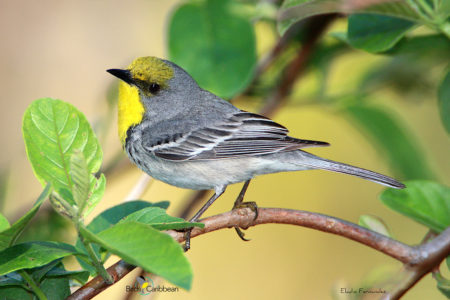
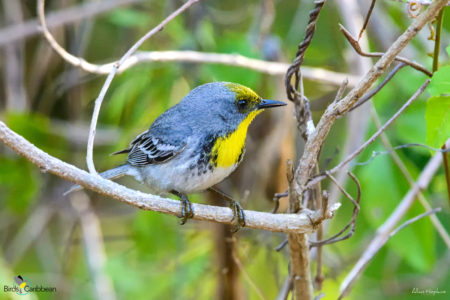
Activity of the Day
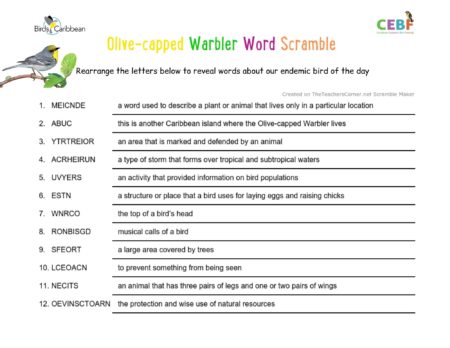 FOR KIDS: Use the information above and the clues on the sheet to untangle our our word scramble – all about the Olive-capped Warbler, you’ll need to know about where is lives, what it eats and how it behaves. You can find all the answers to the clues here.
FOR KIDS: Use the information above and the clues on the sheet to untangle our our word scramble – all about the Olive-capped Warbler, you’ll need to know about where is lives, what it eats and how it behaves. You can find all the answers to the clues here.
FOR KIDS AND ADULTS: As well as living in the northern Bahamas this colourful gray and yellow Caribbean endemic can be found in parts of Cuba. Cuba is an fantastic location for seeing beautiful birds and hosts an amazing 28 cuban endemics. Find out all about our BirdsCaribbean bird tour to Cuba in 2016. Read about what birds did our group saw and which amazing places they managed to visit.
Enjoy the video below of an Olive-capped Warbler in the wild in Cuba and listen to its song!

